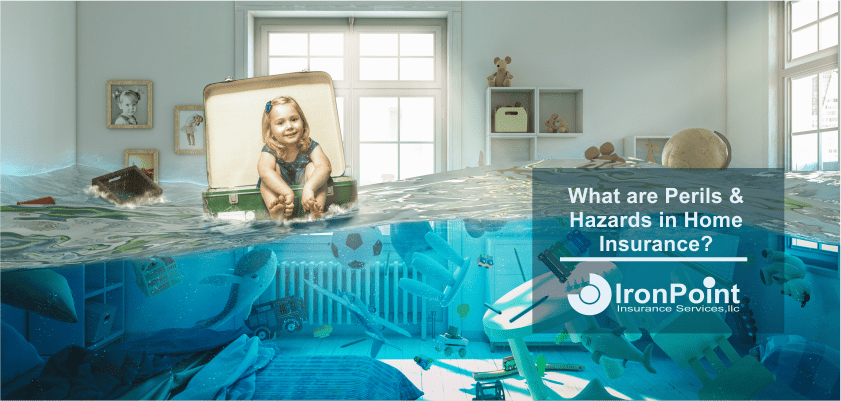Perils & Hazards in Home Insurance: The Fine Print Nobody Reads

Here’s a pop quiz: You’ve just been approved for your dream home mortgage, and the lender asks for proof of “hazard insurance.” Do you know what they’re actually asking for? If you’re scratching your head, you’re not alone.
Perils & hazards in home insurance form the backbone of what’s covered—and what isn’t—in your policy. Yet most homeowners couldn’t tell you the difference if their newly purchased living room depended on it.
Let’s fix that, shall we?
The Insurance Industry’s Secret Language
The insurance world loves its jargon. It’s like a secret handshake that separates the insiders from the rest of us mere mortals just trying to protect our homes.
But here’s the truth: understanding perils & hazards isn’t just insurance trivia—it’s the difference between having your claim approved or being left holding a very expensive bag when disaster strikes.
Perils vs. Hazards: Not Just Semantic Gymnastics
Let’s demystify this once and for all.
- A peril is the actual event that causes damage to your property. Think fire, lightning strike, or that tree that’s been eyeing your roof suspiciously during windstorms.
- A hazard, on the other hand, is a condition that increases the likelihood of a peril occurring. That faulty wiring? Hazard. The dead tree looming over your house? Hazard. Your teenager learning to cook unsupervised? Definite hazard.
It’s a simple cause-and-effect relationship: hazards increase the chances of perils, and perils cause the damage your insurance may (or may not) cover.
The “Hazard Insurance” Misnomer
Here’s where things get interesting—and confusing.
If you’ve ever bought a home or refinanced, you’ve probably heard your mortgage lender mention “hazard insurance.” They say it with such authority that you’d never question it.
But here’s the twist: hazard insurance isn’t actually a type of insurance you can buy.
Shocking, I know.
What your lender is really referring to is the dwelling coverage portion of your homeowners insurance policy—typically listed as “Coverage A” on your policy documents. This is the part that protects the physical structure of your home.
So why the confusing terminology? Because the mortgage industry and insurance industry developed their vocabularies in parallel universes, and nobody bothered to create a translation guide for the rest of us.
What “Hazard Insurance” Actually Covers
When lenders talk about hazard insurance, they’re concerned with protecting their investment—namely, the structure they’ve helped finance. This includes:
- Your home’s roof and structural elements
- Interior walls and flooring
- Permanently installed fixtures
- Built-in appliances (like that water heater that’s making concerning noises)
- Your attached garage
- Other structures physically connected to your home
Notice what’s missing? Your personal belongings, liability protection, detached structures, additional living expenses if your home becomes uninhabitable—essentially everything else that makes a homeowners policy valuable to you rather than just your lender.
Perils: The Good, The Bad, and The Uncovered
Not all perils are created equal in the eyes of your insurance policy. Understanding which ones your policy covers could be the difference between financial security and disaster.
The Sweet 16: Named Perils in Basic Policies
Most basic homeowners policies operate on a “named perils” basis, covering these 16 specific events:
- Fire or lightning (the classics never go out of style)
- Windstorms and hail (Mother Nature’s mood swings)
- Theft (when someone decides your stuff should be their stuff)
- Vandalism or malicious mischief (human nature at its worst)
- Explosions (less common but catastrophic when they happen)
- Weight of ice, snow, and sleet (winter’s unwelcome weight-training program for your roof)
- Falling objects (from meteors to that tree you’ve been meaning to trim)
- Riots or civil commotion (when social unrest meets property damage)
- Smoke damage (even if the fire was next door)
- Damage from aircraft (extremely rare, unless you live near an airport)
- Damage from vehicles (including your teenager’s first parking attempt in the garage)
- Volcanic eruption (admittedly not a concern for most homeowners)
- Accidental water/steam overflow or discharge (when your appliances revolt)
- Sudden and accidental tearing apart, cracking, burning, or bulging of heating and cooling systems
- Sudden and accidental damage from artificially generated electrical current (power surges)
- Freezing of plumbing and household systems
The Outcasts: Perils That Basic Policies Reject
Then there are the perils that standard policies turn away at the door:
- Earthquakes (the earth moves, but your coverage doesn’t)
- Floods (water from the ground up or outside in is almost always excluded)
- Landslides and mudflows (ground movement in any form is unwelcome)
- Termites and pest damage (tiny invaders causing massive damage)
- Mold (unless it’s resulting from a covered water damage claim)
- Acts of war (self-explanatory and thankfully rare)
- Normal wear and tear (that’s maintenance, not insurance)
For these unwelcome guests, you’ll need either special endorsements or separate policies entirely.
Named Perils vs. Open Perils: A Coverage Showdown
When shopping for homeowners insurance, you’ll encounter two approaches to covering perils: named perils and open perils coverage.
- Named perils policies are like exclusive clubs with a strict guest list. If the peril isn’t specifically named on the list, it’s not getting in, and damage from that peril isn’t covered.
- Open perils policies (sometimes called “all-risk” policies, though no policy covers all risks) take the opposite approach. These policies cover all perils EXCEPT those specifically excluded in writing. It’s like saying, “Everyone’s invited to the party except these few troublemakers we’ve banned.”
Open perils coverage is generally more comprehensive and provides broader protection. It shifts the burden of proof, too—instead of you having to prove the damage was caused by a covered peril, the insurance company must prove it was caused by an excluded one.
The difference?
Often just a few dollars a month in premium, but potentially thousands in coverage when disaster strikes.
Beyond the Structure: What Complete Home Insurance Covers
While your lender is laser-focused on the dwelling portion of your policy, you should be thinking more holistically. A complete homeowners policy includes:
- Dwelling coverage (what lenders call “hazard insurance”)
- Other structures coverage for detached garages, fences, and sheds
- Personal property coverage for your belongings
- Loss of use coverage for additional living expenses if your home becomes uninhabitable
- Personal liability protection if someone is injured on your property or you accidentally damage others’ property
- Medical payments coverage for minor injuries to guests, regardless of fault
Plus optional coverages for specific needs:
- Identity theft protection
- Scheduled personal property for high-value items
- Water backup coverage
- Home business coverage
- Equipment breakdown protection
Hazards: The Risk Factors Insurers Eye Suspiciously
Insurance companies are in the business of assessing risk, and certain hazards make them very nervous. These risk factors generally fall into four categories:
Physical Hazards
Elements of your property that increase the likelihood of damage:
- Aging roof
- Outdated electrical systems
- Old plumbing
- Dead trees near the structure
- Swimming pools without proper fencing
Moral Hazards
Factors that might tempt someone to commit insurance fraud:
- Excessive debt
- Properties significantly over-insured
- History of suspicious claims
Morale Hazards
Behaviors that show a careless attitude toward risk:
- Poor maintenance
- Ignoring safety precautions
- Disregarding building codes
Legal Hazards
Circumstances that could increase liability:
- Home businesses with client traffic
- Aggressive dog breeds
- Trampolines without safety features
- Rental activities without proper insurance
Addressing these hazards doesn’t just lower your premium—it makes your home genuinely safer and reduces the risk of devastating losses.
Get The FREE Home Insurance Review Checklist
Quickly identify coverage gaps and strengthen your insurance protection with our easy and FREE Home Insurance Review Checklist.
Taking Action: Three Steps to Proper Protection
- Review your current policy to determine if you have named perils or open perils coverage. If you can’t tell, that’s a red flag—call your agent immediately.
- Consider the excluded perils that might affect your area. Live in a flood zone or on a fault line? Standard coverage won’t help. You need specialized policies.
- Assess the hazards around your home and address them proactively. Not only will this potentially lower your premiums, but it also reduces the likelihood you’ll ever need to file a claim.
Remember, the best home insurance claim is the one you never have to file. Understanding perils & hazards isn’t just about ensuring coverage—it’s about creating a safer home in the first place.
Insurance may seem complex, but it doesn’t have to be. With a clear understanding of perils & hazards, you can navigate this crucial protection with confidence, ensuring your home—and everything in it—remains safe from whatever perils come your way.
The Bottom Line: Reading Between the Policy Lines
It’s easy to focus exclusively on the numbers when buying insurance—the premium, the deductible, the coverage limits. But the real story of your protection lies in the policy language.
A policy with named perils coverage might have identical-looking limits to an open perils policy, but the actual protection they provide could differ dramatically when disaster strikes.
This is why working with a knowledgeable agent matters. They can translate insurance-speak into plain English and help you understand not just how much coverage you have, but exactly what that coverage includes.
If you’re looking to learn more or want to explore home insurance options, contact us today. Don’t like the phone, start the conversation online. We are always ready and willing to help.
Let’s Get Started
Select the way you want to start your quote.
Let’s Get In Touch
Compare Quote Online
Let’s Get Started

Want to know if you can save on home or auto insurance? See for yourself. Start a quote today.
Call today and speak with a professional insurance agent.
1-877-334-7646






